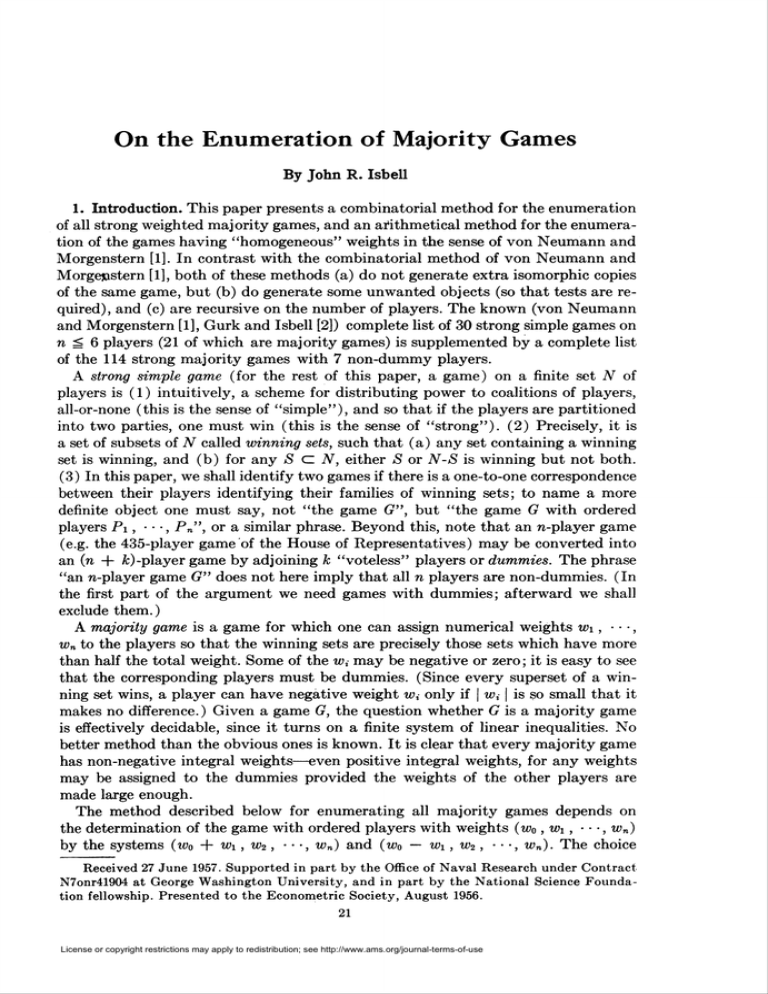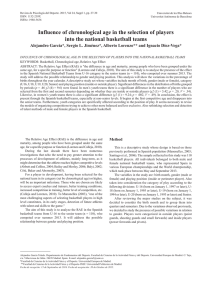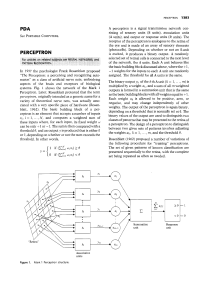On the Enumeration of Majority Games
Anuncio

On the Enumeration
of Majority
Games
By John R. Isbell
1. Introduction. This paper presents a combinatorial method for the enumeration
of all strong weighted majority games, and an arithmetical method for the enumeration of the games having "homogeneous" weights in the sense of von Neumann and
Morgenstern [1]. In contrast with the combinatorial method of von Neumann and
Morgenstern [1], both of these methods (a) do not generate extra isomorphic copies
of the same game, but (b) do generate some unwanted objects (so that tests are required), and (c) are recursive on the number of players. The known (von Neumann
and Morgenstern [1], Gurk and Isbell [2]) complete list of 30 strong simple games on
«i
6 players (21 of which are majority games) is supplemented by a complete list
of the 114 strong majority games with 7 non-dummy players.
A strong simple game (for the rest of this paper, a game) on a finite set Ar of
players is (1) intuitively, a scheme for distributing power to coalitions of players,
all-or-none (this is the sense of "simple"), and so that if the players are partitioned
into two parties, one must win (this is the sense of "strong").
(2) Precisely, it is
a set of subsets of N called winning sets, such that (a) any set containing a winning
set is winning, and (b) for any S C N, either S or N-S is winning but not both.
(3) In this paper, we shall identify two games if there is a one-to-one correspondence
between their players identifying their families of winning sets; to name a more
definite object one must say, not "the game G", but "the game G with ordered
players Pi, • ■•, Pn", or a similar phrase. Beyond this, note that an n-player game
(e.g. the 435-player game of the House of Representatives)
may be converted into
an (n + fc)-player game by adjoining k "voteless" players or dummies. The phrase
"an n-player game G" does not here imply that all n players are non-dummies. (In
the first part of the argument we need games with dummies; afterward we shall
exclude them.)
A majority game is a game for which one can assign numerical weights w\, • • •,
wn to the players so that the winning sets are precisely those sets which have more
than half the total weight. Some of the w¿ may be negative or zero; it is easy to see
that the corresponding players must be dummies. (Since every superset of a winning set wins, a player can have negative weight w¡ only if | m>,| is so small that it
makes no difference.) Given a game G, the question whether G is a majority game
is effectively decidable, since it turns on a finite system of linear inequalities. No
better method than the obvious ones is known. It is clear that every majority game
has non-negative integral weights—even positive integral weights, for any weights
may be assigned to the dummies provided the weights of the other players are
made large enough.
The method described below for enumerating all majority games depends on
the determination of the game with ordered players with weights (w0, Wi, • • •, w„)
by the systems (w0 + W\, w2, ■■-, wn) and (w0 — W\, w2, ■■-, w„). The choice
Received 27 June 1957. Supported in part by the Office of Naval Research under Contract
N7onr41904 at George Washington
University,
and in part by the National Science Foundation fellowship. Presented to the Econometric
Society, August 1956.
21
License or copyright restrictions may apply to redistribution; see http://www.ams.org/journal-terms-of-use
22
JOHN R. ISBELL
of weights and orderings gives no trouble. However, the method does not generate
weights, but only a, combinatorial description of the game. There is an obvious
formula for weights for the large game in terms of "suitable" weights for the small
games, but we have no version of the method which does not involve both the solution of systems of linear inequalities and the examination of systems which turn
out to be inconsistent. There is, however, a fairly simple combinatorial criterion
which screens out all the inconsistent systems through n = 7.
Weights (wi, • • ■, wn) for a game are called efficient if every winning set S contains a subset which wins by exactly one vote. (This is equivalent to saying that
every minimal winning set wins by one vote. Von Neumann and Morgenstern [1]
call these "homogeneous" weights, but this term seems likely to lead to confusion.)
It is known [3] that efficient weights w¿ for a game with ordered players are unique ;
they are non-negative integers; for any other non-negative integral weights »< belonging to the same game with ordered players, ru, ^ v{ for all i; and when the nonzero weights Wi are arranged in non-decreasing order, they grow no faster than the
Fibonacci numbers. We call a non-decreasing sequence of positive integers (wi,
■■■, wk) an efficient sequence if it is an initial segment of some non-decreasing efficient game weights (wi, ■• ■, wk , ■• ■, w„). We find a characterization
of these and
a recursive arithmetical method for generating them, which generates nothing but
efficient sequences. It is necessary, of course, to select those which are actually
game weights; for n = 7 there are 23 games in the 99 efficient sequences. The test
for this is simple, and the whole computation is far easier than the other one de-
scribed above.
It is known [3] that for n =g 4 there are at least 2n_4 efficient weighted majority
games with n non-dummy players. We obtain the upper bound (n — 1 ) !—actually
an upper bound for the number of efficient sequences. There is even more room
between the known bounds for general majority games with n non-dummy players;
we find there are more than 2" for nâ8,
but no upper bound is known short of
22 (the number of sets of sets of players).
A little experimentation with the methods presented here will quickly show the
desirability of an arithmetical method for enumerating all majority games. This
would presumably involve a unique choice of weights for each game. For n i£ 7
each n-player majority game has minimum non-negative integral weights «>,-. (That
is, for any non-negative integral m defining the same game and order, Wi ¿ Vi.for
each i.) Such weights are clearly unique. However, they do not always exist, as we
show with a certain 12-player game.
To put the classes of games in perspective, consider the author's manuscript list
of 559 non-majority 7-player games without dummies, thought to be free from
duplications. It was computed by the von Neumann-Morgenstern
method some
years ago and 109 of the 114 majority games were found.
2. The operators Hx and H2. We wish to formalize the construction described
by the symbol (w0 — Wi, w2, ■■■, wn). A motion of a game is a permutation of its
players taking winning sets to winning sets. Under the group of motions of the game
the players sweep through transitivity sets which we call roles. A court is a majority
game with a distinguished role. A natural ordering of the players of a majority game
is an ordering (Pi, • • -, Pn) such that the game has weights wt such that iv\ ^
License or copyright restrictions may apply to redistribution; see http://www.ams.org/journal-terms-of-use
ON THE
ií!¿
(Pi,
ENUMERATION
OF MAJORITY
GAMES
23
• • • è»>.
However, a natural ordering of the players of a court is an ordering
■■-, P„) such that Pi is an element of the distinguished role and for some
weights Wi, w2 ^ • • ■ Ï; wn .
Lemma 1. If (wi, ■■-, wn) and (vi , • • -, vn) are two systems of weights for a ma-
jority game G with ordered players Pi, • • •, P„ , and wx S; ■• • ^ w„ , and a is a
permutation of the integers from 1 to n such that vam ^ • • • ^ va(n) , then P, —->Pa(i)
is a motion of G.
Proof. If Wi ^ w¡ and S is a winning set containing j but not i then replacing j
by í in S yields another winning set, since it does not decrease the weight. If also
Vj ^ Vi then i and j may be exchanged (by a motion leaving all other players fixed).
Then the lemma follows by induction.
For any majority game G of n + 1 ^ 2 players, we define an n-player court
Hi(G) and an n-player game H2(G) as follows. It suffices to define games with
ordered players, H with players Qi, ■• ■, Qn , H' with players Ri, ■■■, R„ , specifying that H1(G) consists of the game H with the role of Qi distinguished and H2(G)
is the game H'. Let (w0, • • •, wn) be any system of weights for G, arranged so that
w'o è • • • ^ w„ . We define H by its weights (w0 — u\ , w2, ■■-, w„), and H' by
its weights (wo + Wi, • ■•, wn).
Lemma 2. Hi(G) and H2(G) are determined by the game G; and together they deter-
mine G.
Proof. The first half is a routine analysis of definitions, and we omit it. For the
converse, let G and G' be majority games with H-¡(G) = Hi(G') = Hi and H2(G) =
H2(G') = H2. Naturally
order the player Qi, • • -, Qn of the court Hi and the
players Ri, ■■-, Rn of the court H2. Since Hi = Hi(G), there exist weights w0 è
• • • ^ wn for G and a one-to-one correspondence <pmapping the last n — \ players
P2, • • •, Pn , of G upon n — 1 of the players of Hi so that the omitted player of Hi
is a member of the distinguished
role and the numbers Wo — W\ , w2, ■■■, wn,
assigned according to <p,are weights for Hi . By Lemma 1 and the definition of a
role, there is a motion a of Hi such that a(<p(Pj))
= Q¡ îor j = 2, ■■■, n. By the
same device we may regularize the correspondences of G to H2, G' to Hi and G'
to H2, so that players with like indices from 2 to n correspond. For any set S of
indices in {0, 1, • • -, n], by considering the four possible values of <Sn {0, 1}, one
can give necessary and sufficient conditions for {P, | i e S] to be a winning set in
G, in terms of Hi, H2, and S. The same conditions are necessary and sufficient for
[Pi1 | i t S] to win in G'. Therefore the correspondence P¿ <->P/ is an isomorphism
between G and G'.
We call an n-player court Hi and n-player majority game H2 compatible if there
exists a majority game G such that HX(G) = Hi and H2(G) = H2. Evidently one
can define a combinatorial scheme on the lines of a game, which must be the game
G iî G exists. The necessary and sufficient condition for compatibility is then the
solvability of the system of linear inequalities defining weights for G, together with
the axioms for a game. Reformulating, one has
Theorem 1. An n-player court Hi with naturally ordered players Q{ and an n-player
majority game H2 with naturally ordered players Ri are compatible if and only if both
(a) whenever {Qi \ i t S] is a winning set in Hi containing the player Qi, then
\Ri\i e S and i ^ 2} is a winning set in H2, and
(b) there exist weights Uifor Hi, Vifor H2, such that Ui = Vifor i = 2, ■■■, n.
License or copyright restrictions may apply to redistribution; see http://www.ams.org/journal-terms-of-use
24
JOHN
R. ISBELL
Proof. The necessity of (a) and (b) is obvious. Conversely, suppose (a) and (b)
are valid. We may replace each w, with max (w,, 0), and v¡ with max (v¡, 0),
without affecting either game (since players with negative weight are dummies)
or the validity of (a) and (b). We claim the numbers (vi + «i)/2, (vi — ux)/2,
u2, • ■■,un are weights for a game G with players P0, Pi, ■■■, Pn . Call the subsets
oî N = {P0, ■■■ , Pn] having more than half the total weight winning sets. For
any S cz N, not both S and N-S are winning. One must win unless they have the
same weight; but in that case it is clear that two complementary
sets in Hi or in
H2 would have the same weight, which is impossible. To prove that any superset
of a winning set wins, it suffices to adjoin players one at a time. Adjoining a player
other than Pi cannot decrease the weight. Next suppose S is a winning set containing Po and not Pi. Then the set {Q,■| j = 1 or j ^ 2 and Pj e S] is a winning set
in Hi, by computation ; the set {Rj \j = 1 or j ^ 2 and Pj e S] is a winning set
in H2, by (a) and the fact that supersets of winning sets win in H2 ; and »Su {Pij
wins in G, by computation. If S is a winning set containing neither P0 nor Pi, then
N-S contains both but fails to win; hence N-S-{Pi} cannot win either, and Su {Pi}
is a winning, set. Thus G is a game, and therefore a majority game. To show that
Hi = HiiG) and H2 = H2(G) it remains to prove that the ordering (Pc , ' • • , Pn)
is natural. Replacing Pi with Po never turns a winning set into a losing set, since
«i =ï 0. If »Sis a winning set containing P2 and not Pi , and furthermore S contains
Po, then S u {Px} — {P2} wins in virtue of (a). Then the same is true if P0 is not
in S, by passage to the complement. For i = 2, ■• ■ , n — 1, the natural ordering
of the players of Hi implies that replacing Pl+i by Pt never turns a winning set
into a losing set. Therefore we may rearrange the given weights for G into weights
«)o è • • • ^ »nby successive transpositions,
and the proof is complete.
The author's experience suggests that (b) of Theorem 1 mayas well be ignored
in computation; this is discussed in Section 4 below.
Corollary
1. For every n-player court Hi there exists an n-player majority game
compatible with Hi.
In fact there exists an n-player majority game compatible with all n-player
courts. One system of weights for it is (1, 0, •■ -, 0) ; but as we noted before, any
weights may be assigned to the n — 1 dummies provided the first weight is large
enough.
Corollary
2. Let f(n) be the number of different n-player majority games, g(n)
the number of these which hove no dummies. Thenf(n-\1) ^ 2/(n) — landg(n-\1)
â 2g(n) - 1. Forn > 6, fin) > 2", and for n > 1, gin) > 2".
Proof. Every majority game has at least two roles, with the exception of the
games having weights (1, 1, • ■-, 1), of which there is one for each odd number of
players. In any case the number of n-player courts is at least 2/(n) — 1 and the
number without dummies is at least 2g(n) — 1. Corollary 1 and Lemma 2 show
that there are at least as many corresponding n + 1-player majority games; and
clearly G cannot have any dummies when Hi(G) has none. Then if f(n) > 2", it
follows that fin + 1) > 2n+1; and the list at the end of the paper shows that
fil)
= 135 > 27. The same induction applies for g; and though gil) is only 114,
the list shows there are over 256 corresponding courts.
The true order of / and g is not known. No respectable
License or copyright restrictions may apply to redistribution; see http://www.ams.org/journal-terms-of-use
upper bound is known,
ON THE ENUMERATION
OF MAJORITY GAMES
25
though one can make slight improvements on 22 , which is the number of sets of
sets of players. (Of course, the lower bound 2" may be as wide of the mark.)
3. Efficient sequences. In this section we shall consider only games without dummies; it is also convenient to reverse our convention as to ordering. Let a sequence
be a finite non-decreasing sequence of positive integers. For any sequence w =
(wi, • • • , Wn), let w(N) be the total Sî~" to,-; for any subset S of N = {1, • • •, n},
let wiS) be 2, e sWi. Then wiS) is called the weight of iS.
Weights ÍWí) for a majority game are efficient provided w(N) is an odd number
2p — 1 and every subset of weight greater than p contains a subset of weight exactly p. These conditions automatically make (w/) weights for a game, but the absence of zeros does not imply the absence of dummies. (Example: 1, 2, 2, 2.) We
are assuming there are no dummies; that is, every index is in some set of weight p.
Then it is known [2, 3] that the efficient weights are uniquely determined by the
game, namely as minimum integral weights, and that their growth is restricted by
the inequality
(*)
M>,á 1+
ZjZtWj.
For any sequence w, let us call the non-negative integer p acceptable for w provided every set of weight >p contains a subset of weight exactly p. Clearly 0 is
acceptable for each w, no integer from 1 to wn — 1 can be acceptable, a sum of
acceptable numbers is acceptable, and all sufficiently large numbers are acceptable.
Lemma 3. p > 0 is acceptable for (wi, ■■■ , wn+i ) if and only if both p and
p — Wn+iare acceptable for (wi, ■■■ ,w„).
Proof. If p is acceptable for the long sequence it is clearly acceptable for a part
of the sequence. If p — wn+i is not acceptable for (wi, ■■■ , wn), one has a set S
such that w(S) > p — w„+i and S contains no subset of weight exactly p — wn+i.
Since the Wi are increasing, one can assure that w(S) < p. Then S u {n + lj can
contain no subset of weight p, a contradiction. The converse is obvious.
Now let us call p admissible for w if both p and w(N) + 1 — p are acceptable;
p is proper ifl ^ p ^ w(N). Let the sequence w be efficient provided it satisfies
(*) and some proper p is admissible for w.
Theorem 2. A sequence w is an efficient sequence if and only if w is an initial
segment of the iincreasing) weights for some efficient weighted majority game.
Proof. If w is an efficient sequence with proper admissible
p ^ p' = w(N) + 1 — p,
then p + p' is acceptable, hence admissible, for (wi, • • • ,wn,p,p'),
by four applications of the lemma. To show that every index is in a set of weight p + p' it
suffices, by efficiency, to show that this is true of the least index. Suppose * is the
least index actually used; if i > 1 then by (*), w,; is ^ the sum of the preceding
weights, and i can be replaced by a set of smaller indices without diminishing the
weight, which reduces to a contradiction.
For the converse, (*) is established in a previous paper [3], and the rest is clear
from the lemma. Note that (*) assures that for n > 1, one of p and w(N) + 1 — p
is >wn, so that subtracting w„ leaves a proper integer.
License or copyright restrictions may apply to redistribution; see http://www.ams.org/journal-terms-of-use
26
Theorem
JOHN R. ISBELL
3. Let (wi, ■• • , w„) be efficient. Then (wi,
• • • , wn , wn+i) is efficient
is and only if (I) wn+i 2: w„, (2) wj„+i ^ 1 + 2"Ji t«¿, and (3) wn+i = h — kfor
some h and k which are admissible for (íüi , • ■• ,w„). A proper p is admissible for
(Wl,
■ ■■ , Wn+l)
if and only if both p and p — wn+i are admissible for (wi, ■■■ wn).
Proof. The last statement follows from the lemma and the rest follows from that.
Note that since 0 is always admissible, the possible values of wn+i always include
the proper admissible numbers. There are not always at least two of these. However,
it is known [3] that there are at least 2n_4 n-player games with efficient weights, for
n ^ 4. From Theorem 3 and the proof of Theorem 2 we see that the number of
efficient sequences of length n is an increasing function of n and lies between the
numbers of efficient game weights of length n and of length n + 2. In the other
direction we have
Theorem 4. For an efficient sequence (wi , • ■• , w„) there are at most n values of
wn+i which make (wi, • • • wn+i) efficient. Hence the number of efficient sequences of
length n is between 2n~ and (n — 1) !.
Proof. There are at most n acceptable integers 8* between wn and w(N) + 1 — wn ,
namely, wn , wn + w„-i, • • • , w(N); for clearly if this sequence skips over p,
Sk < p < s^+i, then at step k -f- 1 we have a set of weight >p which drops below
p if its smallest element is removed. Now wn+i itself need not be acceptable, but
w(N) + 1 — Wn+i is. For there are p and p' acceptable for (wi, • • • , wn) such that
p + p' = w(N) + w„+i + 1. By the lemma, both p — wn+\ and p' — w„+i are
acceptable for (wi, ■■■ , wp) ; hence so is their sum, which is w(N) + 1 — wn+i.
This establishes the inductive step, and a glance at the case n = 1 establishes the
upper bound (n — 1)!. The lower bound 2™~4is established in [3] for n ^ 4, and
the cases n = 1, 2, 3 are easily verified.
4. The enumeration. A method for generating all majority games of n + 1 players
from a list of all n-player majority games is as follows. List all the courst (II, r),
H an n-player majority game and r a role of H. For each (H, r) there is at least
one compatible game Il2, as pointed out in Corollary 1 to Theorem 1. All compatible
games must be determined. In some cases (e.g. when H2 has weights (1, 0, • • • , 0))
one can write down weights for the corresponding n + 1-player game G by rote.
In general, however, one must screen the possible values of H2 and solve the systems of linear inequalities defining weights for G. For hand computation
it seems
best to apply the necessary condition (a) of Theorem 1, and for each H2 satisfying
that condition, to attempt to solve the inequalities for weights for G with the side
conditiont w( ^ 0. In a run such as the enumeration of the 7-player majority games
one develops subroutines; for example, there are different courts Hi , Hi, such that
H2 is compatible with Hi if and only if H2 is compatible with Hi', and one may
make mental lists of the corresponding classes of games H2.
It appears to be feasible though far from routine to code this method for automatic
computation. No attempt has been made. For automatic computation it might be
preferable simply to ignore the combinatorial conditions (a) and deal entirely in
inequalities. However, (a) is a highly effective screen; for n ^ 6 every pair (Hi, H2)
satisfying (a) is compatible.
License or copyright restrictions may apply to redistribution; see http://www.ams.org/journal-terms-of-use
ON THE
ENUMERATION
OF MAJORITY
27
GAMES
The method expounded by von Neumann and Morgenstern [1] for enumerating
all strong simple games involves, necessarily, a listing of winning sets (no other
way is known for describing these games in general) ; and it also involves obtaining
and then eliminating multiple isomorphic copies of each game. No other method is
known for this problem. However, for generating a list of majority games, the present method is far superior. Note that if one were to employ the method of von
Neumann and Morgenstern for this special purpose it would still be necessary to
examine the inequalities determining whether each game has weights.
The recursive enumeration of all efficient sequences involves additional information which is most easily generated from the beginning, the efficient sequence (wi),
where wi = 1. One may lay out three columns on a sheet of paper, the first giving
the sequence (wi, • ■■ , wn), the second the list of all integers from 0 to w(N) which
are admissible for w, and the third the list of all differences of integers in the second
column which satisfy the inequalities (1) and (2) of Theorem 3. The numbers in
the third column are precisely the values of w„+i which can be used for an extension
(wi, ••• ,wn, Wn+i); Theorem 3 tells how to compute the second column for
(wi, ■■■ , wH+i), using the entries in the first column of this row and in the second
column of the earlier row; then the new third column is computed from the new
first and second columns. Coding this computation
should be routine; the only
complication is the irregularity of the size of the clumps of numbers.
It would certainly be desirable to develop a method for the enumeration of all
majority games which, like the method for efficient sequences, should deal directly
with arithmetic properties of the weights. A prerequisite would seem to be a scheme
for assigning unique weights (not necessarily integers) to each game. The obvious
idea of taking minimal integral weights is not enough, because these are not unique.
To see this, consider the two sets of weights (1, 3, 5, 6, 8, 11, 12, 23, 28, 31, 31, 38)
and (1, 3, 5, 7, 8, 11, 12, 23, 28, 31, 31, 37). One may verify that these weights determine
the same game. One then proves
twelve lemmas
which show that
any
weights for this game are at least as large as (1, 3, 5, 6, 8, 11, 12, 23, 28, 31, 31,
37). First lemma: the first player is not a dummy; hence his weight in integers
must be at least 1. The proof that the second weight must be at least 3 involves
finding combinations of 1, 3, 11, and 12. Having all this, one observes that the
twelve minimum values do not form weights for any game, since they permit a tie ;
there are no integers between them and the two sets of weights, and therefore both
are minimal.
It can be shown by similar arguments that the 135 sets of weights listed below
are all minimum. (Criteria from a previous paper [3] aid in most of the verifications.) In particular, no two of the 135 games are isomorphic. Comparable care has
been taken to assure that no game is omitted. The list for n g 5 is taken from von
Neumann and Morgenstern [1], and the list for n = 6 from Gurk and Isbell [2].
The 15 efficient weighted majority games of less than seven players
1
111
1112
11111
11113
11122
11223
111112
111114
111123
111224
111233
111334
112225
112335
The 6 nonefficient weighted majority games of less than seven players
111222
112223
112234
122233
122334
License or copyright restrictions may apply to redistribution; see http://www.ams.org/journal-terms-of-use
122345
28
JOHN R. ISBELL
The 23 seven-player efficient weighted majority games
1111111
1111113
1111115
1111122
1111124
1111133
1111223
1111234
1111335
1111344
1111445
1112222
1112226
1112244
1112336
1112446
1113337
1113447
1122227
1122355
1122557
1123338
1123558
The 91 seven-player nonefficient weighted majority games
1111223
1111333
1112224
1112233
1112235
1112334
1112345
1113335
1113346
1122223
1122225
1122234
1122236
1122245
1122333
1122335
1122337
1122344
1122346
1122445
1122447
1122456
1123334
University
1123345
1123356
1123446
1123457
1133344
1133355
1133445
1133456
1133467
1133557
1133568
1222233
1222235
1222334
1222336
1222345
1222347
1222356
1222455
1222556
1222567
1223335
1223337
of Washington,
Seattle,
1223344
1223346
1223348
1223357
1223445
1223447
1223449
1223456
1223458
1223467
1223559
1224457
1224558
1224569
1233345
1233446
1233455
1233457
1233468
1233556
1233567
1233578
1234456
1234557
1234568
1234579
1244567
1244679
2222333
2223334
2223345
2223367
2233344
2233445
2233456
2233478
2234455
2234556
2234567
2234589
2334456
2344567
2345678
3334455
3345567
Washington
1. J. Von Neumann
& O. Morgenstern,
Theory of Games and Economic Behavior,
Princeton Univ. Press, New Jersey, 1944.
2. H. M. Gurk & J. R. Isbell,
"Simple solutions,"
to appear in Annals of Mathematics
Studies, Contributions to the Theory of Games, V. 4, Princeton Univ. Press, New Jersey.
3. J. R. Isbell,
"A class of majority games," Quart. Jn. of Math., Ser. 2, V. 7, 1956, p.
183-187.
License or copyright restrictions may apply to redistribution; see http://www.ams.org/journal-terms-of-use







